Chapter 8: Angular Kinetics
Problems & Exercises
8.2 Torque
- (a) When opening a door, you push on it perpendicularly with a force of 55.0 N at a distance of 0.850m from the hinges. What torque are you exerting relative to the hinges?
(b) Does it matter if you push at the same height as the hinges?
Solution: (a) [latex]\text{46.8 N·m}[/latex]; (b) It does not matter at what height you push. The torque depends on only the magnitude of the force applied and the perpendicular distance of the force’s application from the hinges. (Children don’t have a tougher time opening a door because they push lower than adults, they have a tougher time because they don’t push far enough from the hinges.) - When tightening a bolt, you push perpendicularly on a wrench with a force of 165 N at a distance of 0.140 m from the center of the bolt.
(a) How much torque are you exerting in newton × meters (relative to the center of the bolt)?
(b) Convert this torque to footpounds. - Two children push on opposite sides of a door during play. Both push horizontally and perpendicular to the door. One child pushes with a force of 17.5 N at a distance of 0.600 m from the hinges, and the second child pushes at a distance of 0.450 m. What force must the second child exert to keep the door from moving? Assume friction is negligible.
Solution: 23.3 N - Use the second condition for equilibrium [latex]\text{(net τ = 0)}[/latex] to calculate [latex]{F}_{\text{p}}[/latex] in the She Saw Torques example from Chapter 8.2, employing any data given or solved for in part (a) of the example.
- Repeat the She Saw Torques example from Chapter 8.2, with the center of mass of the seesaw 0.160 m to the left of the pivot (on the side of the lighter child) and assuming a mass of 12.0 kg for the seesaw. The other data given in the example remain unchanged. Explicitly show how you follow the steps in the Problem-Solving Strategy for static equilibrium.
Solution: Given: [latex]\begin{array}{ccc}{m}_{1}& =& \text{26.0 kg,}\phantom{\rule{0.25em}{0ex}}{m}_{2}=\text{32.0 kg,}\phantom{\rule{0.25em}{0ex}}{m}_{\text{s}}=\text{12.0 kg,}\phantom{\rule{0.25em}{0ex}}\\ {r}_{1}& =& \text{1.60 m,}\phantom{\rule{0.25em}{0ex}}{r}_{\text{s}}=\text{0.160 m, find (a)}\phantom{\rule{0.25em}{0ex}}{r}_{2,\phantom{\rule{0.25em}{0ex}}}\text{(b)}\phantom{\rule{0.25em}{0ex}}{F}_{\text{p}}\end{array}[/latex]
a) Since children are balancing:
[latex]\begin{array}{}\text{net}\phantom{\rule{0.25em}{0ex}}{\tau }_{\text{cw}}=–\text{net}\phantom{\rule{0.25em}{0ex}}{\tau }_{\text{ccw}}\\ ⇒{w}_{1}{r}_{1}+{m}_{\text{s}}{\mathit{gr}}_{\text{s}}={w}_{2}{r}_{2}\\ \end{array}[/latex]
So, solving for [latex]{r}_{2}[/latex] gives:
[latex]\begin{array}{lll}{r}_{2}& =& \frac{{w}_{1}{r}_{1}+{m}_{\text{s}}{\mathit{gr}}_{\text{s}}}{{w}_{2}}=\frac{{m}_{1}{\mathit{gr}}_{1}+{m}_{\text{s}}{\mathit{gr}}_{\text{s}}}{{m}_{2}g}=\frac{{m}_{1}{r}_{1}+{m}_{\text{s}}{r}_{\text{s}}}{{m}_{2}}\\ & =& \frac{\left(\text{26.0 kg}\right)\left(\text{1.60 m}\right)+\left(\text{12.0 kg}\right)\left(\text{0.160 m}\right)}{\text{32.0 kg}}\\ & =& \text{1.36 m}\end{array}[/latex]
b) Since the children are not moving:
[latex]\begin{array}{}\text{net}\phantom{\rule{0.25em}{0ex}}F=0={F}_{\text{p}}–{w}_{1}–{w}_{2}–{w}_{\text{s}}\\ ⇒{F}_{\text{p}}={w}_{1}+{w}_{2}+{w}_{s}\end{array}[/latex]
So that
[latex]\begin{array}{lll}{F}_{\text{p}}& =& \left(\text{26.0 kg}+\text{32.0 kg}+\text{12.0 kg}\right)\left(\text{9.80}\phantom{\rule{0.25em}{0ex}}\text{m}/{\text{s}}^{2}\right)\\ & =& \text{686 N}\end{array}[/latex]
8.3 Stability
- Suppose a horse leans against a wall as in the figure below. Calculate the force exerted on the wall assuming that force is horizontal while using the data in the schematic representation of the situation. Note that the force exerted on the wall is equal in magnitude and opposite in direction to the force exerted on the horse, keeping it in equilibrium. The total mass of the horse and rider is 500 kg. Take the data to be accurate to three digit
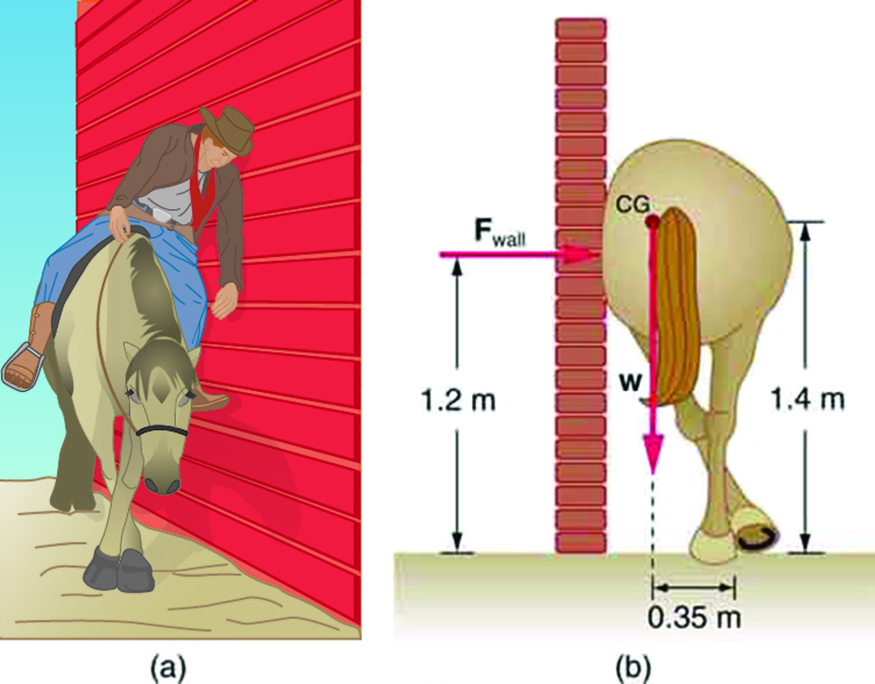
Solution: [latex]{F}_{\text{wall}}=1.43×{\text{10}}^{3}\phantom{\rule{0.25em}{0ex}}\text{N}[/latex] - Two children of mass 20.0 kg and 30.0 kg sit balanced on a seesaw with the pivot point located at the center of the seesaw. If the children are separated by a distance of 3.00 m, at what distance from the pivot point is the small child sitting in order to maintain the balance?
- (a) Calculate the magnitude and direction of the force on each foot of the horse in the question above(two are on the ground), assuming the center of mass of the horse is midway between the feet. The total mass of the horse and rider is 500kg.
(b) What is the minimum coefficient of friction between the hooves and ground? Note that the force exerted by the wall is horizontal.
Solution: (a) [latex]\text{2.55}{×10}^{3}\phantom{\rule{0.25em}{0ex}}\text{N, 16.3º to the left of vertical (i.e., toward the wall)}[/latex]; (b) 0.292 - A person carries a plank of wood 2.00 m long with one hand pushing down on it at one end with a force [latex]{\text{F}}_{1}[/latex] and the other hand holding it up at .500 m from the end of the plank with force [latex]{\text{F}}_{2}[/latex]. If the plank has a mass of 20.0 kg and its center of gravity is at the middle of the plank, what are the magnitudes of the forces [latex]{\text{F}}_{1}[/latex] and [latex]{\text{F}}_{2}[/latex]?
- A 17.0-m-high and 11.0-m-long wall under construction and its bracing are shown in the figure. The wall is in stable equilibrium without the bracing but can pivot at its base. Calculate the force exerted by each of the 10 braces if a strong wind exerts a horizontal force of 650 N on each square meter of the wall. Assume that the net force from the wind acts at a height halfway up the wall and that all braces exert equal forces parallel to their lengths. Neglect the thickness of the wall.
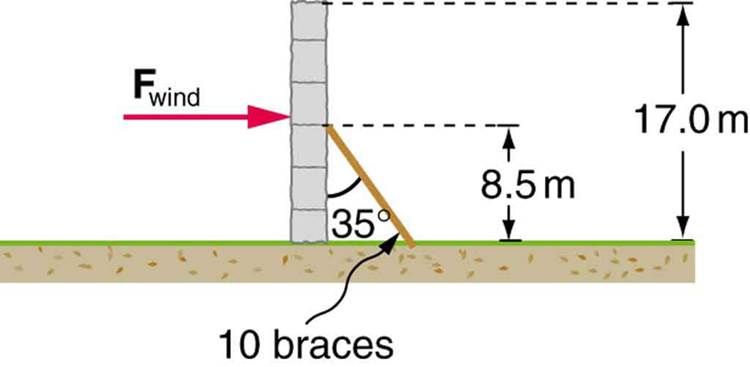
Solution: [latex]{F}_{\text{B}}=2.12×{\text{10}}^{4}\phantom{\rule{0.25em}{0ex}}\text{N}[/latex] - (a) What force must be exerted by the wind to support a 2.50-kg chicken in the position shown in the figure?
(b) What is the ratio of this force to the chicken’s weight?
(c) Does this support the contention that the chicken has a relatively stable construction?
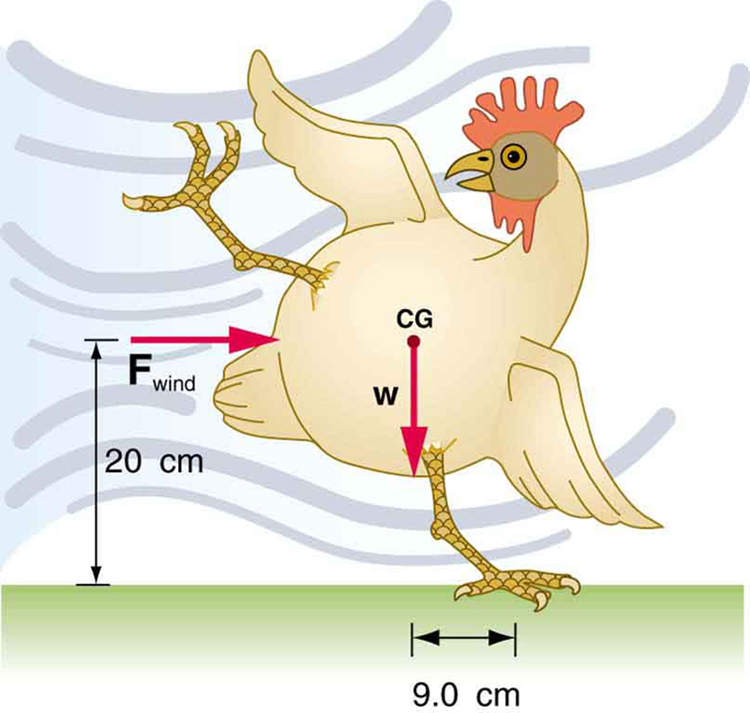
- Suppose the weight of the drawbridge in the figure is supported entirely by its hinges and the opposite shore, so that its cables are slack. The mass of the bridge is 2500 kg. (a) What fraction of the weight is supported by the opposite shore if the point of support is directly beneath the cable attachments? (b) What is the direction and magnitude of the force the hinges exert on the bridge under these circumstances?
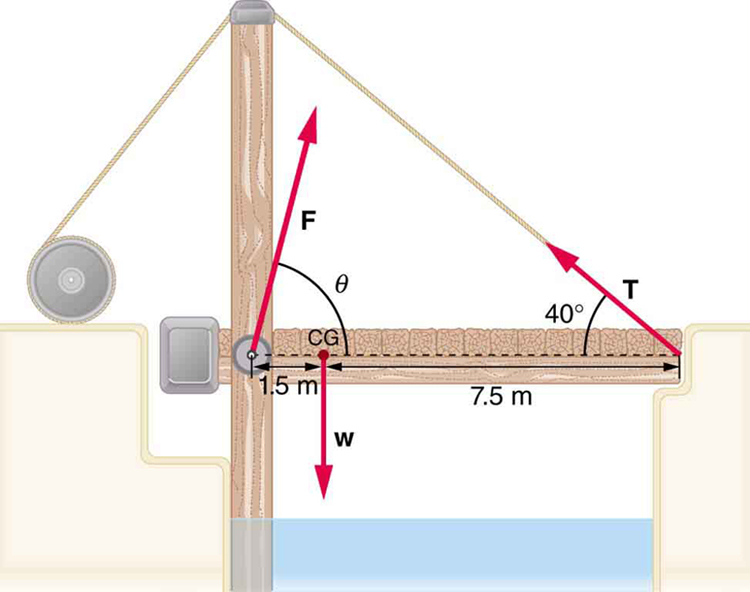
A small drawbridge, showing the forces on the hinges ([latex]\text{F}[/latex]), its weight ([latex]\text{w}[/latex]), and the tension in its wires ([latex]\text{T}[/latex]). Solution: (a) 0.167, or about one-sixth of the weight is supported by the opposite shore; (b) [latex]F=2\text{.}0×{\text{10}}^{4}\phantom{\rule{0.25em}{0ex}}\text{N}[/latex], straight up.
- Suppose a 900-kg car is on the bridge in the figure above with its center of mass halfway between the hinges and the cable attachments. (The bridge is supported by the cables and hinges only.)
(a) Find the force in the cables.
(b) Find the direction and magnitude of the force exerted by the hinges on the bridge. - A sandwich board advertising sign is constructed as shown in the figure below. The sign’s mass is 8.00 kg.
(a) Calculate the tension in the chain assuming no friction between the legs and the sidewalk.
(b) What force is exerted by each side on the hinge?
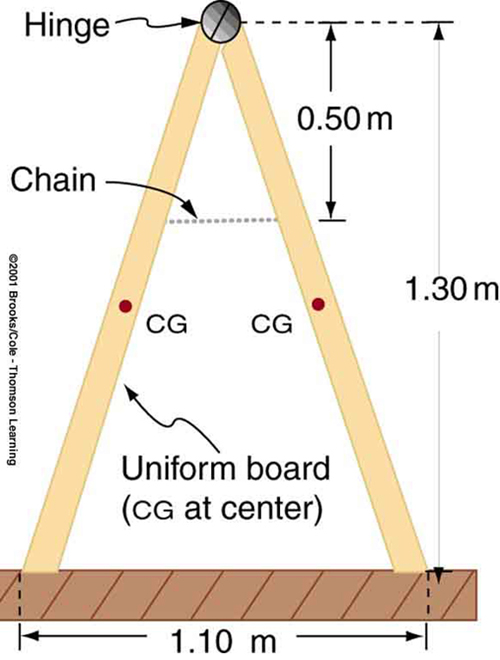
Solution: (a) 21.6 N; (b) 21.6 N - (a) What minimum coefficient of friction is needed between the legs and the ground to keep the sign in the figure above in the position shown if the chain breaks?
(b) What force is exerted by each side on the hinge? - A gymnast is attempting to perform splits. From the information given in the figure below, calculate the magnitude and direction of the force exerted on each foot by the floor.
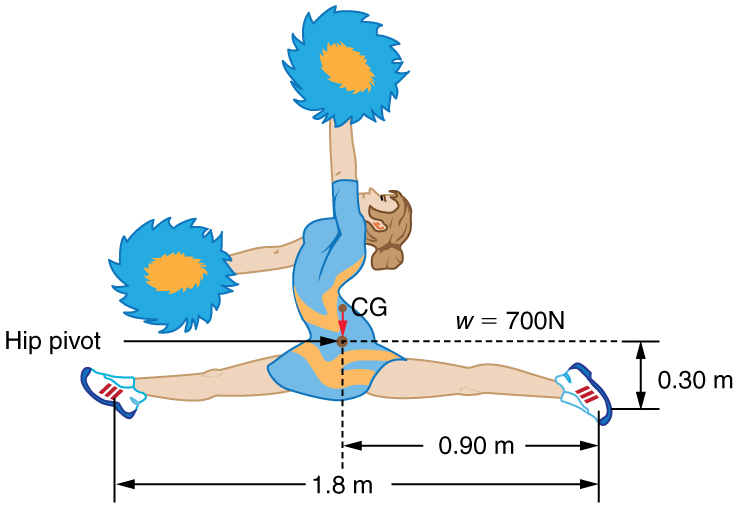
A gymnast performs full split. The center of gravity and the various distances from it are shown. Solution: 50 N directly upwards
8.4 Applications of Statics, Including Problem-Solving Strategies
- To get up on the roof, a person (mass 70.0 kg) places a 6.00-m aluminum ladder (mass 10.0 kg) against the house on a concrete pad with the base of the ladder 2.00 m from the house. The ladder rests against a plastic rain gutter, which we can assume to be frictionless. The center of mass of the ladder is 2 m from the bottom. The person is standing 3 m from the bottom. What are the magnitudes of the forces on the ladder at the top and bottom?
- In figure (a) below, the cg of the pole held by the pole vaulter is 2.00 m from the left hand, and the hands are 0.700 m apart. Calculate the force exerted by
(a) his right hand and
(b) his left hand
(c) If each hand supports half the weight of the pole in figure (b) below, show that the second condition for equilibrium [latex]\text{(net}\phantom{\rule{0.25em}{0ex}}{\tau }_{}=\text{0)}[/latex] is satisfied for a pivot other than the one located at the center of gravity of the pole. Explicitly show how you follow the steps in the Problem-Solving Strategy for static equilibrium described above.
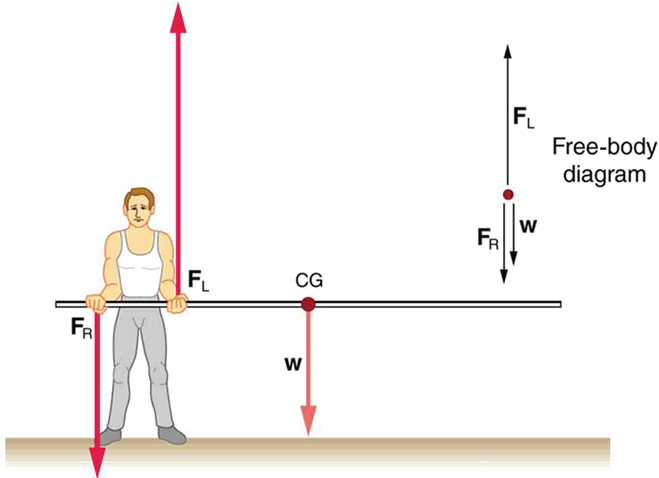 (a);
(a); 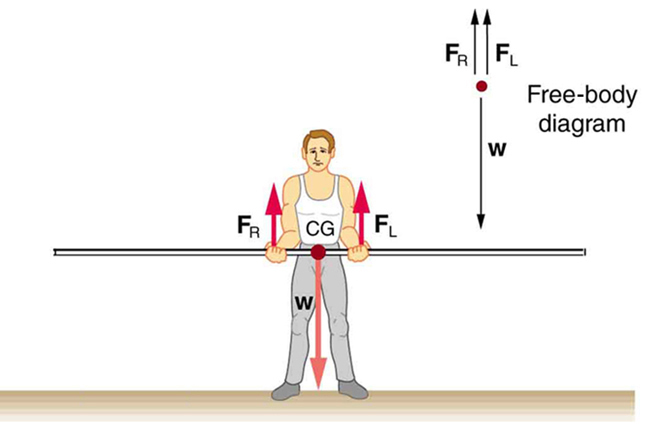 (b)
(b)
8.5 Simple Machines
- What is the mechanical advantage of a nail puller—similar to the one shown in the figure below —where you exert a force [latex]\text{45 cm}[/latex] from the pivot and the nail is [latex]\text{1.8 cm}[/latex] on the other side? What minimum force must you exert to apply a force of [latex]\text{1250 N}[/latex] to the nail?
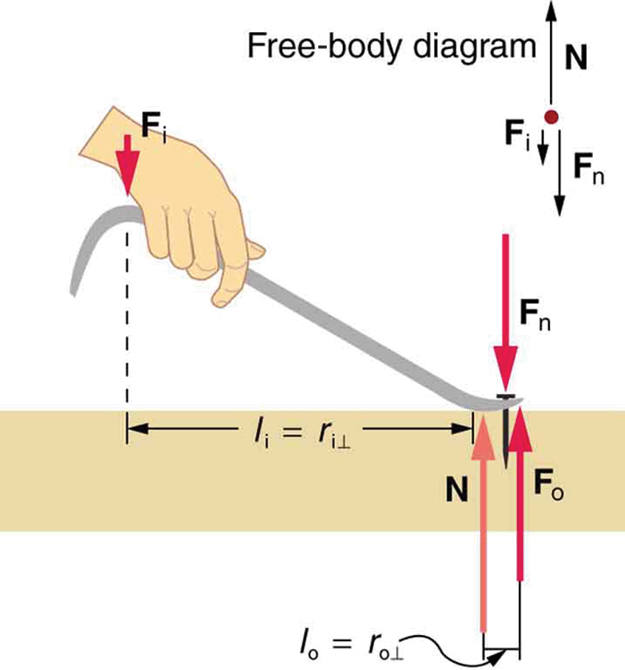
Solution: 25; 50 N - Suppose you needed to raise a 250-kg mower a distance of 6.0 cm above the ground to change a tire. If you had a 2.0-m long lever, where would you place the fulcrum if your force was limited to 300 N?
- a) What is the mechanical advantage of a wheelbarrow, such as the one in the figure below, if the center of gravity of the wheelbarrow and its load has a perpendicular lever arm of 5.50 cm, while the hands have a perpendicular lever arm of 1.02 m? (b) What upward force should you exert to support the wheelbarrow and its load if their combined mass is 55.0 kg? (c) What force does the wheel exert on the ground?
 Solution: (a) [latex]\text{MA}=\text{18}\text{.}5[/latex]; (b) [latex]{F}_{\text{i}}=\text{29.1 N}[/latex]; (c) 510 N downward
Solution: (a) [latex]\text{MA}=\text{18}\text{.}5[/latex]; (b) [latex]{F}_{\text{i}}=\text{29.1 N}[/latex]; (c) 510 N downward - A typical car has an axle with [latex]1\text{.}\text{10 cm}[/latex] radius driving a tire with a radius of [latex]\text{27}\text{.5 cm}[/latex]. What is its mechanical advantage assuming the very simplified model in figure (b)?
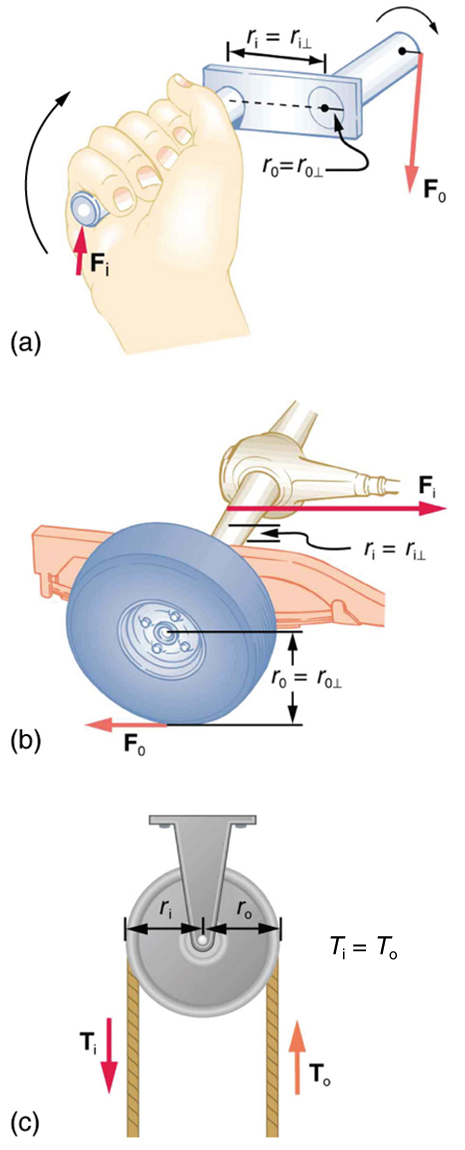
- What force does the nail puller in the figure above exert on the supporting surface? The nail puller has a mass of 2.10 kg.
Solution: [latex]1\text{.}\text{3}×{\text{10}}^{3}\phantom{\rule{0.25em}{0ex}}\text{N}[/latex] - If you used an ideal pulley of the type shown in figure (a) to support a car engine of mass [latex]\text{115 kg}[/latex],
(a) What would be the tension in the rope?
(b) What force must the ceiling supply, assuming you pull straight down on the rope? Neglect the pulley system’s mass.
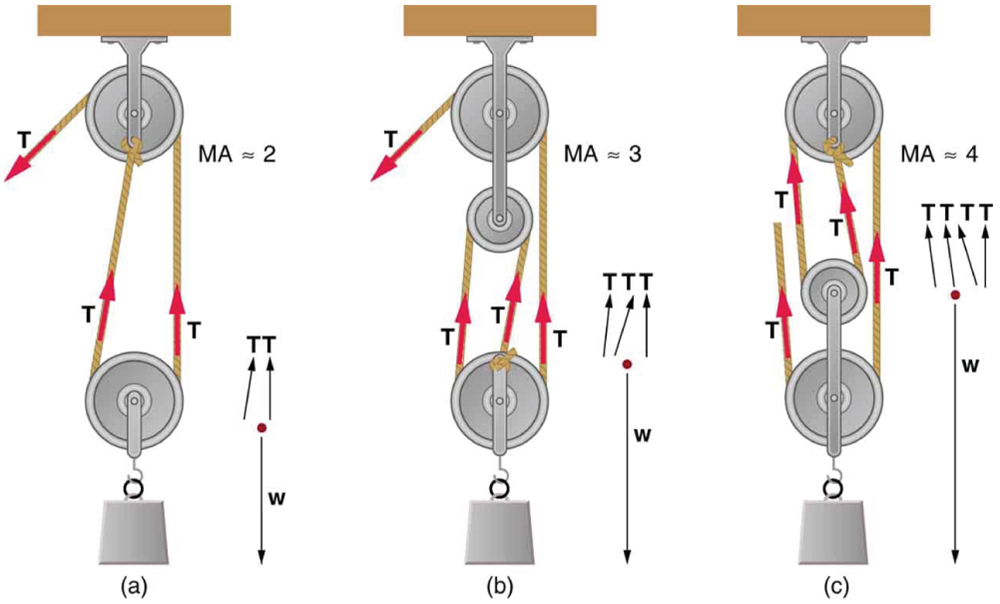
- Repeat the question above for the pulley shown in figure (c), assuming you pull straight up on the rope. The pulley system’s mass is [latex]\text{7.00 kg}[/latex].
Solution: (a) [latex]T=\text{299 N}[/latex]; (b) 897 N upward
8.6 Forces and Torques in Muscles and Joints
- Verify that the force in the elbow joint in the figure below is 407 N, as stated in the text.
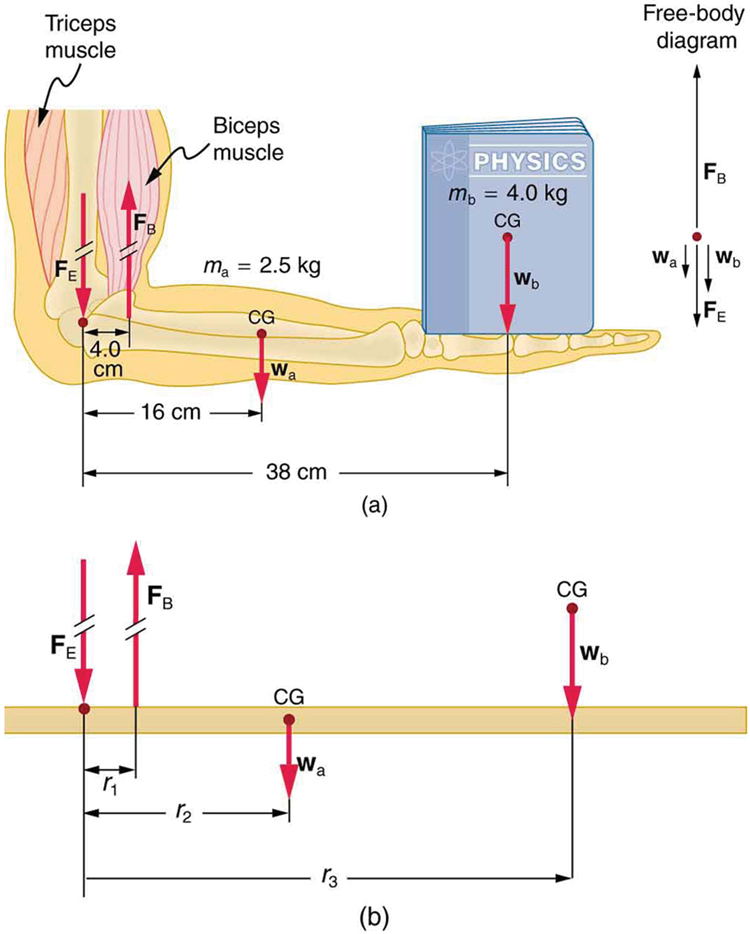
Solution: [latex]\begin{array}{lll}{F}_{\text{B}}& =& \text{470 N;}\phantom{\rule{0.25em}{0ex}}{r}_{1}=\text{4.00 cm;}\phantom{\rule{0.25em}{0ex}}{w}_{\text{a}}=\text{2.50 kg;}\phantom{\rule{0.25em}{0ex}}{r}_{2}=\text{16.0 cm;}{w}_{\text{b}}=\text{4.00 kg;}\phantom{\rule{0.25em}{0ex}}{r}_{3}=\text{38.0 cm}\\ {F}_{\text{E}}& =& {w}_{\text{a}}\left(\frac{{r}_{2}}{{r}_{1}}-1\right)+{w}_{\text{b}}\left(\frac{{r}_{3}}{{r}_{1}}-1\right)\\ & =& \left(\text{2.50 kg}\right)\left(9.80\phantom{\rule{0.25em}{0ex}}\text{m}/{\text{s}}^{2}\right)\left(\frac{\text{16.0 cm}}{\text{4.0 cm}}–1\right)\\ & & +\left(\text{4.00 kg}\right)\left(9.80\phantom{\rule{0.25em}{0ex}}\text{m}/{\text{s}}^{2}\right)\left(\frac{\text{38.0 cm}}{\text{4.00 cm}}–1\right)\\ & =& \text{407 N}\end{array}[/latex] - Two muscles in the back of the leg pull on the Achilles tendon as shown in the figure below. What total force do they exert?

The muscles in the back of the leg pull the Achilles tendon when one stands on one’s toes. A simplified lever system is shown. - The upper leg muscle (quadriceps) exerts a force of 1250 N, which is carried by a tendon over the kneecap (the patella) at the angles shown in the figure below. Find the direction and magnitude of the force exerted by the kneecap on the upper leg bone (the femur).
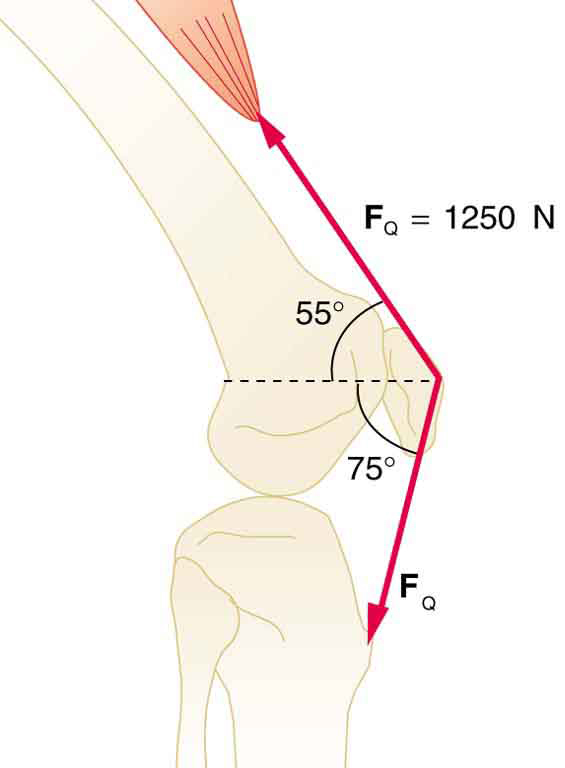
Solution: [latex]\begin{array}{c}1.1×{\text{10}}^{3\phantom{\rule{0.25em}{0ex}}}\text{N}\\ \theta =\text{190}\text{º}\phantom{\rule{0.25em}{0ex}}\text{ccw from positive}\phantom{\rule{0.25em}{0ex}}x\phantom{\rule{0.25em}{0ex}}\text{axis}\end{array}[/latex] - A device for exercising the upper leg muscle is shown in the figure below, together with a schematic representation of an equivalent lever system. Calculate the force exerted by the upper leg muscle to lift the mass at a constant speed. Explicitly show how you follow the steps in the Problem-Solving Strategy for static equilibrium in Chapter 8.4: Applications of Statistics, Including Problem-Solving Strategies.
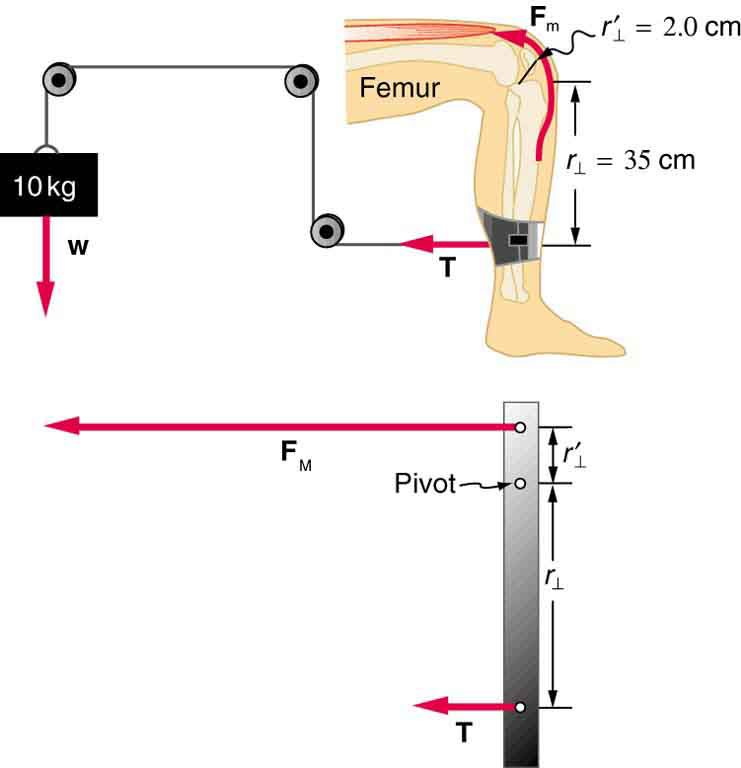
- A person working at a drafting board may hold her head as shown in the figure below, requiring muscle action to support the head. The three major acting forces are shown. Calculate the direction and magnitude of the force supplied by the upper vertebrae [latex]{\mathbf{\text{F}}}_{\text{V}}[/latex] to hold the head stationary, assuming that this force acts along a line through the center of mass as do the weight and muscle force.

Solution: [latex]{F}_{\text{V}}=\text{97}\phantom{\rule{0.25em}{0ex}}\text{N,}\phantom{\rule{0.25em}{0ex}}\theta =\text{59º}[/latex] - We analyzed the biceps muscle example with the angle between forearm and upper arm set at [latex]\text{90º}[/latex]. Using the same numbers as in the example in Chapter 8.6, find the force exerted by the biceps muscle when the angle is [latex]\text{120º}[/latex] and the forearm is in a downward position.
- Even when the head is held erect, as in the figure below, its center of mass is not directly over the principal point of support (the atlanto-occipital joint). The muscles at the back of the neck should therefore exert a force to keep the head erect. That is why your head falls forward when you fall asleep in the class. (a) Calculate the force exerted by these muscles using the information in the figure. (b) What is the force exerted by the pivot on the head?
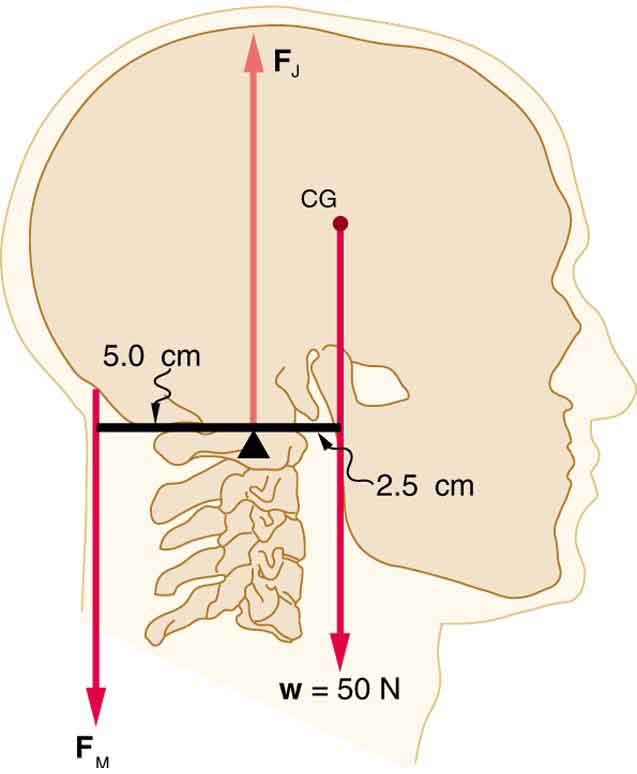
The center of mass of the head lies in front of its major point of support, requiring muscle action to hold the head erect. A simplified lever system is shown. Solution: (a) 25 N downward; (b) 75 N upward
- A 75-kg man stands on his toes by exerting an upward force through the Achilles tendon, as in the figure below.
(a) What is the force in the Achilles tendon if he stands on one foot?
(b) Calculate the force at the pivot of the simplified lever system shown—that force is representative of forces in the ankle joint.

The muscles in the back of the leg pull the Achilles tendon when one stands on one’s toes. A simplified lever system is shown. Solution: (a) [latex]{F}_{\text{A}}=2\text{.}\text{21}×{\text{10}}^{3}\phantom{\rule{0.25em}{0ex}}\text{N}[/latex] upward; (b) [latex]{F}_{\text{B}}=\text{2.94}×{\text{10}}^{3}\phantom{\rule{0.25em}{0ex}}\text{N}[/latex] downward
- A father lifts his child as shown in the figure below. What force should the upper leg muscle exert to lift the child at a constant speed?
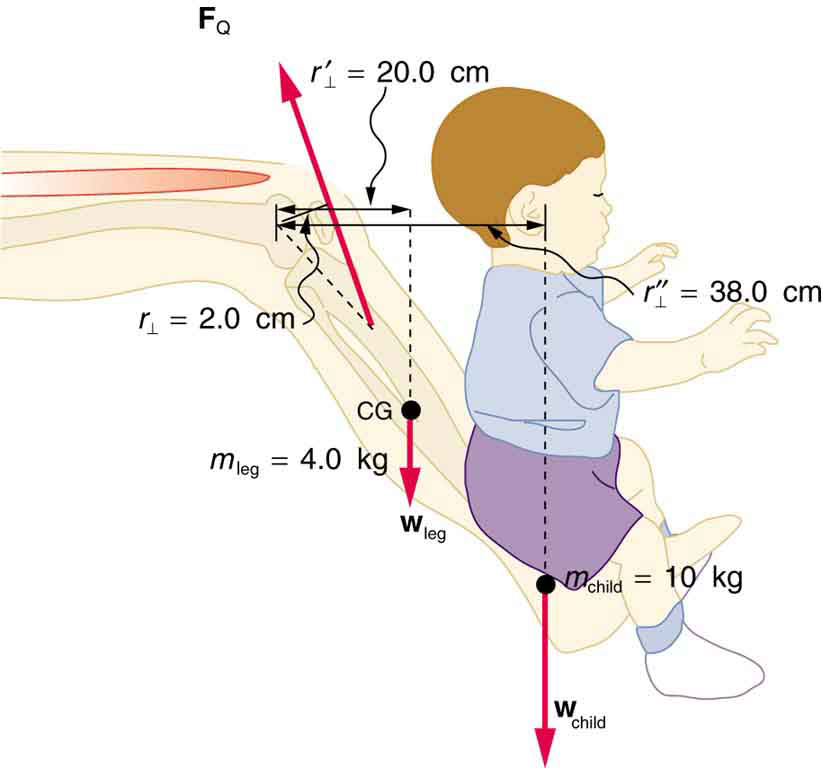
- Unlike most of the other muscles in our bodies, the masseter muscle in the jaw, as illustrated in the figure below, is attached relatively far from the joint, enabling large forces to be exerted by the back teeth.
(a) Using the information in the figure, calculate the force exerted by the lower teeth on the bullet.
(b) Calculate the force on the joint.
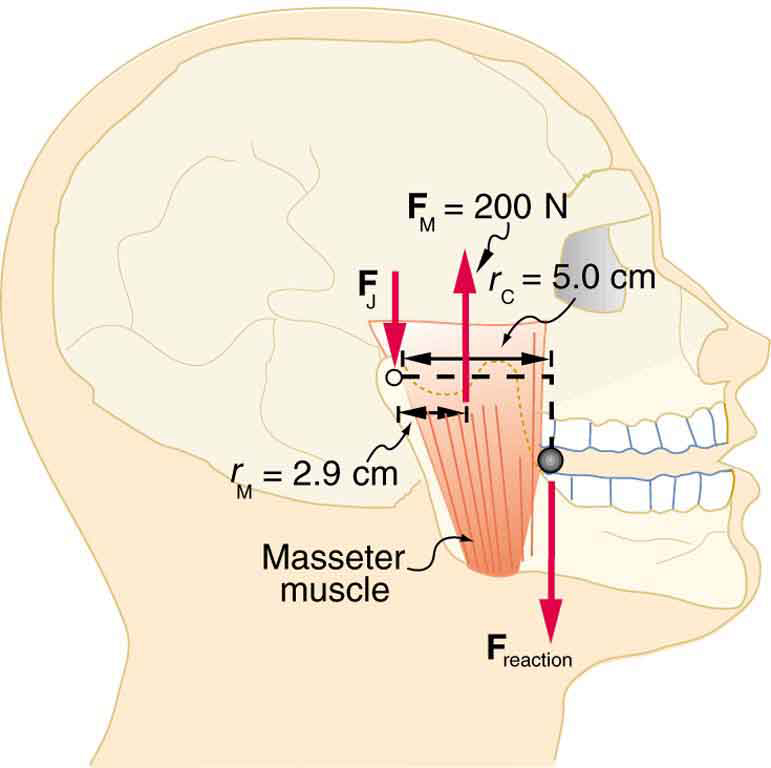
A person clenching a bullet between his teeth. Solution: (a) [latex]{F}_{\text{teeth on bullet}}=\text{1.2}×{\text{10}}^{\text{2}}\phantom{\rule{0.25em}{0ex}}\text{N}[/latex] upward; (b) [latex]{F}_{\text{J}}=\text{84 N}[/latex] downward
- Suppose we replace the 4.0-kg book in the example from Chapter 8.6 of the biceps muscle with an elastic exercise rope that obeys Hooke’s Law. Assume its force constant [latex]k=\text{600}\phantom{\rule{0.25em}{0ex}}\text{N/m}[/latex].
(a) How much is the rope stretched (past equilibrium) to provide the same force [latex]{F}_{\text{B}}[/latex] as in this example? Assume the rope is held in the hand at the same location as the book.
(b) What force is on the biceps muscle if the exercise rope is pulled straight up so that the forearm makes an angle of [latex]\text{25º}[/latex] with the horizontal? Assume the biceps muscle is still perpendicular to the forearm. - (a) What force should the woman in the figure below exert on the floor with each hand to do a push-up? Assume that she moves up at a constant speed.
(b) The triceps muscle at the back of her upper arm has an effective lever arm of 1.75 cm, and she exerts force on the floor at a horizontal distance of 20.0 cm from the elbow joint. Calculate the magnitude of the force in each triceps muscle, and compare it to her weight.
(c) How much work does she do if her center of mass rises 0.240 m?
(d) What is her useful power output if she does 25 pushups in one minute?
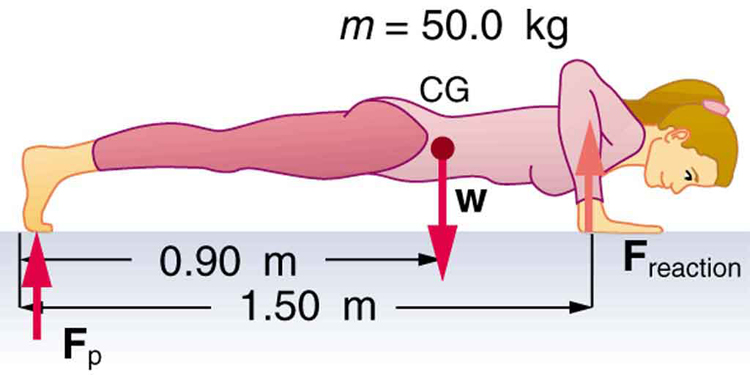
Solution: (a) 147 N downward; (b) 1680 N, 3.4 times her weight; (c) 118 J; (d) 49.0 W - You have just planted a sturdy 2-m-tall palm tree in your front lawn for your mother’s birthday. Your brother kicks a 500 g ball, which hits the top of the tree at a speed of 5 m/s and stays in contact with it for 10 ms. The ball falls to the ground near the base of the tree and the recoil of the tree is minimal.
(a) What is the force on the tree?
(b) The length of the sturdy section of the root is only 20 cm. Furthermore, the soil around the roots is loose and we can assume that an effective force is applied at the tip of the 20 cm length. What is the effective force exerted by the end of the tip of the root to keep the tree from toppling? Assume the tree will be uprooted rather than bend.
(c) What could you have done to ensure that the tree does not uproot easily? - Unreasonable Results: Suppose two children are using a uniform seesaw that is 3.00 m long and has its center of mass over the pivot. The first child has a mass of 30.0 kg and sits 1.40 m from the pivot.
(a) Calculate where the second 18.0 kg child must sit to balance the seesaw.
(b) What is unreasonable about the result?
(c) Which premise is unreasonable, or which premises are inconsistent?
Solution: (a) [latex]{\stackrel{-}{x}}_{2}=\text{2.33 m}[/latex]; (b) The seesaw is 3.0 m long, and hence, there is only 1.50 m of board on the other side of the pivot. The second child is off the board. (c) The position of the first child must be shortened, i.e. brought closer to the pivot. - Construct Your Own Problem: Consider a method for measuring the mass of a person’s arm in anatomical studies. The subject lies on her back, extends her relaxed arm to the side and two scales are placed below the arm. One is placed under the elbow and the other under the back of her hand. Construct a problem in which you calculate the mass of the arm and find its center of mass based on the scale readings and the distances of the scales from the shoulder joint. You must include a free body diagram of the arm to direct the analysis. Consider changing the position of the scale under the hand to provide more information, if needed. You may wish to consult references to obtain reasonable mass values.
Additional Problems
-
*In order to lift a shovelful of dirt, a gardener pushes downward on the end of the shovel and pulls upward at distance l2 from the end, as shown below. The weight of the shovel is mg and acts at the point of application of F2. Calculate the magnitudes of the forces F1 and F2 as functions of l1, l2, mg, and the weight W of the load. Why do your answers not depend on the angle θ that the shovel makes with the horizontal?
Solution: W(l1/l2−1);Wl1/l2+mg

